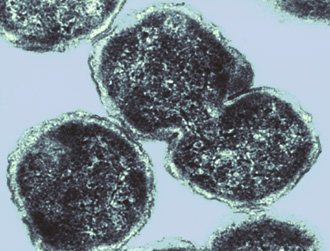P. denitrificans has also been extensively studied for its ability to grow on C1 compounds such as methanol and methylamine, which it does by oxidation to carbon dioxide, then assimilation via the Calvin cycle. Poly(3-hydroxybutyrate) is produced as a storage compound during growth on methanol, poly(3-hydroxyvalerate) during growth on n -pentanol, and a mixed polymer during growth on n -propanol. The organism can also grow as a chemolithoautotroph, using inorganic energy sources with carbon dioxide as the carbon source. Possible energy sources are hydrogen, and sulfur compounds such as thiosulfate, and P. denitrificans is now being exploited as a model organism for the study of poorly characterized sulfur compound transformations. Metabolic flexibility in this organism is reflected in an underlying flexibility of regulatory networks, which are currently only partially understood. Paracoccus is a biochemically versatile Genus, with a wide range of diverse degradative capabilities and potential applications in bioremediation. Strains have been isolated that utilize thiocyanate as an energy source, for the possible bioremediation of thiocyanate-contaminated wastewater from coke-oven factories. Strains that degrade halobenzoates under anaerobic denitrifying conditions, and that degrade sulfonates including cysteate, taurine, 2-hydroxyethanesulfonate, sulfoacetate and 3-aminopropanesulfonate under anaerobic growth conditions have been described. Several strains of P. denitrificans have been isolated that grow chemolithoautotrophically using carbon disulfide or carbonyl sulfide as energy sources, and strains have been isolated from activated sludge that are capable of degrading quaternary carbon compounds such as dimethylmalonate under denitrifying conditions. Another strain isolated from activated sludge degrades a variety of methylated amines under both aerobic and anaerobic conditions. Some strains are capable of 'aerobic denitrification', the complete dissimilation of nitrate to dinitrogen (or nitrous oxide) under aerobic growth conditions. P. denitrificans also has the very unusual ability to oxidize ammonia to nitrite during growth on organic energy sources ('heterotrophic nitrification'). Coupled to denitrification, heterotrophic nitrification allows for the complete transformation of ammonia to dinitrogen by a single organism. The availability of a genome sequence and the subsequent follow-up work will shed further light on the diverse and unusual metabolic capabilities of P. denitrificans . ReferenceBaker, S.C., Ferguson, S.J., Ludwig, B., Page, M.D., Richter, O.M., and van Spanning, R.J. (1998) Molecular genetics of the genus Paracoccus : metabolically versatile bacteria with bioenergetic flexibility. Microbiology and Molecular Biology Reviews 62 : 1046-1078. |
||
|
||
Paracoccus denitrificans 1222

 The
image was taken by Richard Evans-Gowing at the University of
East Anglia, Norwich, UK. Colorized by Leila Hornick.
The
image was taken by Richard Evans-Gowing at the University of
East Anglia, Norwich, UK. Colorized by Leila Hornick.